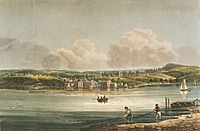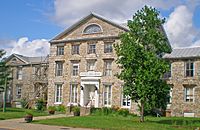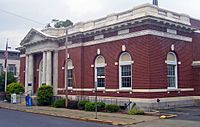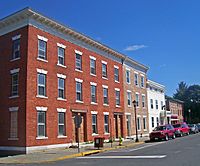Hudson Historic District (New York) facts for kids
Quick facts for kids |
|
|
Hudson Historic District
|
|
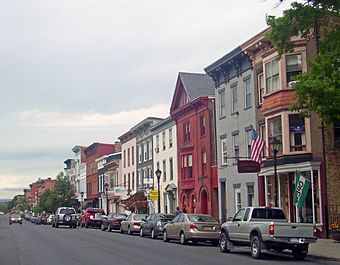
View west along Warren Street from South Fourth, 2008
|
|
| Location | Hudson, NY |
|---|---|
| Area | 139 acres (56 ha) |
| Built | 1783–1935 |
| Architectural style | Various 19th- and 20th-century styles |
| MPS | Hudson MRA |
| NRHP reference No. | 85003363 |
| Added to NRHP | 1985 |
The Hudson Historic District is a special area in downtown Hudson, New York. It's like a giant history book made of buildings! This area covers about 139 acres (56 hectares). It stretches from the Hudson River all the way to near the city's eastern edge.
This district includes 756 important buildings. Most of these buildings were built between 1785 and the mid-1930s. In 1985, this whole area was added to the National Register of Historic Places. This means it's officially recognized as a very important historical place.
Hudson is unique because its city plan, made in the 1700s, is still used today. Warren Street, the main road, is one of the best-preserved 19th-century streets in New York. The oldest buildings here show Hudson's start as a safe place for whalers after the American Revolution. You can even see whales on the street signs today! Later, Hudson became a busy industrial city. It had homes for factory workers and grand houses for factory owners.
Today, people are working hard to protect these old buildings. This has helped Hudson's economy grow. Many antique shops and art galleries have opened on Warren Street. Some people who visit on weekends have even moved to Hudson. They often buy and restore old houses. The city has a special group, the Historic Preservation Commission, to help keep the district's historic look.
Contents
What Does the District Look Like?
The Hudson Historic District has a unique shape. It mostly follows the city's grid plan. The main part of the district is around Warren Street. This street is the heart of Hudson.
The western side of the district includes the area near the Hudson River waterfront. The district has many different types of buildings. You'll see shops on the ground floor in the main areas. There are also some larger homes near the center. Smaller houses are found on the quieter side streets.
Important public buildings are also in the district. These include the Columbia County courthouse and the post office. You can also find several churches and old factory buildings. There are three main open spaces: Promenade Park, Courthouse Square, and another square on the east side.
A Look Back: Hudson's History
Hudson was one of the first cities in America to be carefully planned. Even after its founders were gone, their plan continued to guide the city's growth.
The 1700s: Whalers and a New City
Before 1783, Hudson was just a small waterfront area called Claverack Landing. But that changed when a group of New England whalers arrived. Many of them were Quakers. They were looking for a safe place to keep their ships away from the British during the American Revolution. Claverack Landing was perfect. It was far up the Hudson River, but still reachable by ocean ships.
The whalers bought the land from a Dutch settler. They called themselves the "Proprietors." They divided the land into equal-sized plots. They agreed to either settle the land themselves or sell it cheaply.
By 1785, enough settlers had come from Nantucket and Rhode Island. They were able to officially become a city. Hudson was the first city in New York to be incorporated after America became independent. They set aside a high area, now called Promenade Hill, as a public park. Some settlers even took apart their New England homes and rebuilt them in Hudson!
The new homes they built looked like those from the New England ports they came from. They often had a chimney in the middle. An example is the house at 116 Union Street. They didn't use the Dutch building styles common in the Hudson Valley. The city's grid pattern of streets was also set up early on. Warren Street was planned to be the main shopping street. By 1800, Hudson had 4,000 people. The city grew within this grid for many years. The area north of Warren Street became home to workers. The blocks to the south were for wealthier families.
The 1800s: New Styles and Industry
In the early 1800s, the children of Hudson's founders built homes in the new Federal style. Many two-story brick houses appeared on Front Street and parts of Union and Warren streets. These homes still looked a bit like New England houses. Later Federal style homes, like the Robert Jenkins House at 113 Warren Street, were more fancy. They had marble details and elegant designs.
After the War of 1812, whaling slowed down. But it came back strong in the 1830s. This economic boom brought the Greek Revival style to Hudson. Many buildings in this style were built, especially on Columbia Street. The beautiful Curtis House at 32 Warren Street is a great example.
However, the whaling industry started to decline in the 1840s. This was because petroleum (oil) began to replace whale oil. The building of the Hudson River Railroad also cut the city off from its harbor. This ended Hudson's time as a whaling center. But the railroad and river traffic brought new life to Hudson as an industrial city. Factories that made textiles (cloth) and bricks became important. The Allen Paper Car Wheel Works was a major business. The Cornelius H. Evans House at 414-416 Warren Street shows this time well. It's a large brick house in the Second Empire style. It belonged to a successful local brewer.
The 1900s: Modern Times and Preservation
By the end of the 1800s, some of Hudson's industries were slowing down. But the city's economy was still strong. A new county courthouse was built in 1900. It had a Classical Revival design. The new post office, built a decade later, had similar classical features. By this time, most of the city's grid was built up. The areas near the waterfront became more industrial and less popular for homes. You can find some early 20th-century buildings, like the old YMCA at 521 Union Street.
Most new buildings in the early 1900s were on Warren Street. Four churches and one school were also built.
In 1970, a part of the district was listed on the National Register. But some old buildings were still torn down. When the current Hudson Historic District was created in 1985, those demolished areas were not included.
Important Buildings to See
Two buildings in the district are so special that they are listed on the National Register of Historic Places by themselves. Several others are also very notable.
Buildings on the National Register
- Cornelius H. Evans House: This brick house at 414-416 Warren Street was built in 1861. It's in the Second Empire style. It belonged to a local brewer who was elected mayor twice. It's one of Hudson's most famous buildings. It was the first building in downtown Hudson to be listed on the National Register in 1974.
- U.S. Post Office: This brick building at 402 Union Street was built in 1911. It was designed by James Knox Taylor, a government architect. He added classical decorations to the building. It has two Roman-style porches, similar to the courthouse across the square. It was added to the National Register in 1988.
Other Notable Buildings
- Columbia County Courthouse: This building was designed by Warren & Wetmore in 1900. It's a beautiful Classical Revival style building.
- Commercial building at 260 Warren Street: This is a rare example of a Greek Revival commercial building. It has cool stone posts and beams.
- House at 116 Union Street: Built around 1785, this house is a great example of the early New England style used by Hudson's first settlers.
- Old City Hall: This brick building at 327 Warren Street was built in 1854. It's a late example of the Greek Revival style. For many years, it was the most important public building in the district.
- Robert Jenkins House: This brick house at 113 Warren Street is in the Federal style. It belonged to one of Hudson's early mayors. It's considered one of the best examples of this style in Hudson.
Protecting Hudson's History
In 2003, the city created the Historic Preservation Commission. This group reviews plans for new buildings or big changes to old ones in the district. They want to make sure new construction fits in with the historic look.
The commission has seven members chosen by the mayor. At least one must be an architect, and one a historian. All members must care about preserving old buildings. They meet once a month to review plans and consider which buildings should be named city landmarks.
Images for kids
-
Old City Hall, now Hudson Hall, an arts organization and venue




